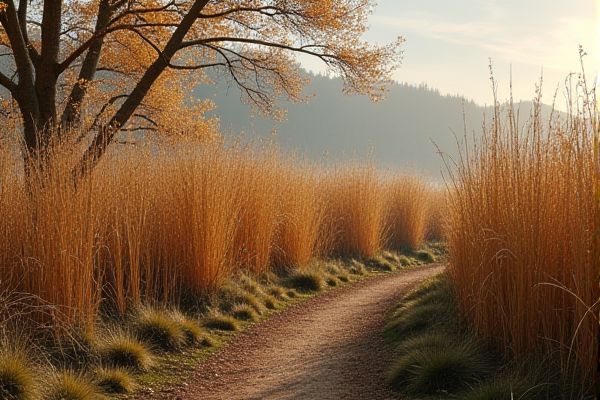
Willow fences offer a sturdy, natural barrier with a rustic look ideal for privacy and garden enclosures, while reed fences provide a lighter, more flexible option that excels in creating decorative screens and windbreaks. Discover the key differences in durability, aesthetics, and installation to choose the perfect fence for your outdoor space by reading the rest of the article.
Table of Comparison
| Feature | Willow Fence | Reed Fence |
|---|---|---|
| Material | Natural willow branches | Dried reed stalks |
| Durability | Moderate; lasts 5-7 years with maintenance | Lower; lasts 3-5 years, more prone to weather damage |
| Appearance | Rustic, sturdy, natural wood look | Lightweight, airy, natural and textured |
| Maintenance | Requires occasional sealing and repairs | Minimal; may need tightening or replacement on damage |
| Installation | Heavier; requires strong support structures | Light; easy to install on existing frames |
| Privacy | High privacy due to dense weaving | Moderate privacy; some gaps between reeds |
| Cost | Higher initial cost due to material and labor | Lower cost; budget-friendly |
| Environmental Impact | Eco-friendly, sustainable if sourced responsibly | Eco-friendly, biodegradable |
Introduction to Willow and Reed Fences
Willow fences, crafted from flexible willow branches, offer durability and natural resistance to weather, making them ideal for long-lasting garden boundaries. Reed fences, made from bundled reed stalks, provide a lightweight, eco-friendly option that blends seamlessly into natural landscapes. Both fence types enhance outdoor spaces with organic textures while serving as effective privacy screens.
Material Composition: Willow vs Reed
Willow fences are crafted from flexible, durable willow branches known for their strength and natural resistance to weather, making them ideal for long-lasting garden enclosures. Reed fences consist of tightly bound thin reed stalks, offering a lighter, more breathable material that excels in providing privacy while allowing some airflow. The choice between willow and reed hinges on desired durability and aesthetic, with willow delivering sturdiness and reed emphasizing lightweight, natural appearance.
Aesthetic Appeal and Design Options
Willow fences offer a natural, textured appearance with flexible branches that can be woven into various intricate patterns, enhancing your garden's rustic charm. Reed fences provide a lighter, airy look with a uniform, slender profile, ideal for creating subtle privacy screens or a relaxed, tropical vibe. Both materials allow diverse design options but differ significantly in visual impact and structural flexibility.
Durability and Lifespan Comparison
Willow fences offer greater durability and a longer lifespan compared to reed fences due to their thicker, sturdier branches that resist weathering and physical damage more effectively. Reed fences tend to deteriorate faster, often lasting only a few years because the slender reeds are more susceptible to moisture and UV damage. Choosing a willow fence for your outdoor space ensures a more robust and enduring boundary solution.
Installation Process and Ease
Willow fences boast a flexible structure that allows for quick and easy installation by weaving the branches onto stakes or panels, making them ideal for DIY projects. Reed fences typically come in pre-rolled panels that can be unrolled and attached directly to an existing structure like a fence or wall, simplifying the setup but requiring some effort with securing fasteners. Both materials offer straightforward installation methods, but willow fences demand more manual weaving, while reed fences rely on fastening pre-made rolls.
Maintenance Requirements
Willow fences require regular pruning to prevent overgrowth and periodic treatment to avoid rot, ensuring longevity and structural integrity. Reed fences demand less frequent upkeep but may need replacement every few years due to weather damage and natural degradation. Your choice depends on how much time and effort you can invest in maintaining a durable, attractive boundary.
Environmental Impact and Sustainability
Willow fences offer superior environmental benefits due to their rapid growth and renewable nature, requiring minimal processing and promoting biodiversity through habitat creation. Reed fences, while renewable and biodegradable, typically involve harvesting from natural wetlands, potentially disrupting aquatic ecosystems and reducing reed bed habitats. Choosing willow fencing supports more sustainable resource management and lower ecological footprints compared to reed alternatives.
Cost Analysis: Willow vs Reed Fencing
Willow fencing typically costs more upfront due to the durability and thicker material used, averaging around $5 to $10 per linear foot, while reed fencing is generally more affordable, around $2 to $6 per linear foot but may require more frequent replacement. Installation expenses for willow fences can be higher because of their weight and sturdiness, whereas reed fences are lighter and easier to install, reducing labor costs. Your choice between willow and reed fencing should consider long-term maintenance costs, as willow fences often provide better longevity, making them a more cost-effective investment despite higher initial expenses.
Best Use Cases for Each Fence Type
Willow fences excel in garden privacy and decorative boundaries due to their dense, flexible branches that provide a natural barrier against wind and sightlines. Reed fences suit coastal areas and patio enclosures where lightweight, moisture-resistant screening is desired, offering a rustic look with good ventilation. Your choice depends on whether you prioritize durability and privacy with willow or breathability and easy installation with reed.
Conclusion: Choosing the Right Fence for Your Needs
Willow fences offer a sturdy, natural barrier with a classic look, ideal for privacy and durability in various climates. Reed fences provide a lightweight, eco-friendly option that enhances aesthetic appeal but may require more frequent replacement due to weather sensitivity. Your choice depends on balancing long-term resilience with decorative style to suit your outdoor space.
 homyna.com
homyna.com